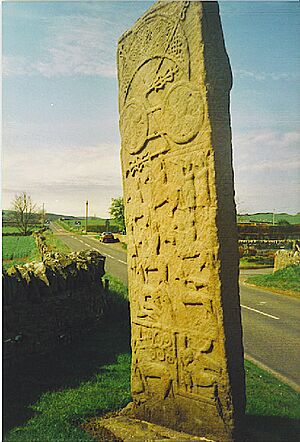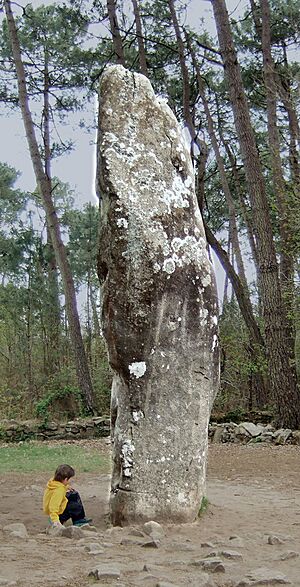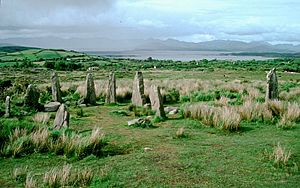Standing stone facts for kids



Standing stones are tall stones placed upright in the ground. People from the Neolithic Age, also called the New Stone Age, set them up. These stones are found in the British Isles and Brittany, France. You can also find them in other parts of the world.
Standing stones can be found alone, in circles, in lines, or in groups. Most of them were put up between 4000 BC and 1500 BC. The people who built them did not have writing. This means we do not know much about why they built them.
Most experts think these stones had two main uses. They were likely meeting places for people. They also probably had special religious or ceremonial purposes. Pottery found near some stones in Europe suggests they were linked to the 'Beaker culture'.
These stones usually have an uneven, squared shape. They often get narrower towards the top. While menhirs are found across Europe, Africa, and Asia, most are in Western Europe. The British Isles (Great Britain and Ireland) and Brittany have the most. There are about 50,000 of these large stone structures in these areas.
It is hard to know the exact age of standing stones. However, pottery found beneath some in Western Europe connects them to the Beaker people. These stones were part of a larger culture that built huge stone structures. This culture was active across Europe and beyond.
When standing stones are found in groups, they often form circles or horseshoe shapes. These groups are sometimes called megalithic monuments. These places were used for ancient religious events. Some even contain burial chambers for the dead. New ways of dating, like radiocarbon dating and tree-ring dating, help us learn their age. In some old sites, we find remains of wooden circles called henges. Woodhenge was one such monument made of timber. It is near the famous Stonehenge in Wiltshire, England.
Contents
Who Built Standing Stones?
We know very little about the people who built these menhirs. We do not know how their societies were organized. We also do not know their religious beliefs or even their language.
However, we do know some things about their lives. They buried their dead carefully. They also knew how to grow crops and farm animals. They were skilled at making pottery, stone tools, and jewelry. Some new studies suggest that megaliths in Brittany might be much older. They could be from six to seven thousand years ago. But this idea is not yet widely accepted by everyone.
Famous Standing Stone Sites
Many famous sites around the world feature standing stones. These places show how important these structures were to ancient people.
Stonehenge
Stonehenge is one of the most famous stone circles in the world. It is in England. People believe it was built over many centuries. It was used for ceremonies and possibly to track the sun and moon.
Avebury
Avebury is another very large stone circle in England. It is even bigger than Stonehenge. It includes a village inside the stone circle. This shows how people lived very close to these ancient sites.
Carnac Stones
The Carnac stones are in Brittany, France. They are a huge collection of standing stones. There are thousands of them lined up in rows. It is one of the largest groups of megalithic stones in the world.
Images for kids
-
Large menhir located between Millstreet and Ballinagree, County Cork, Ireland
-
Cwm Rhaeadr Fawr maen hir (menhir) near Aber Falls, Gwynedd, Wales
-
Dry Tree menhir – a standing stone at Goonhilly Downs Cornwall
See also
 In Spanish: Menhir para niños
In Spanish: Menhir para niños





